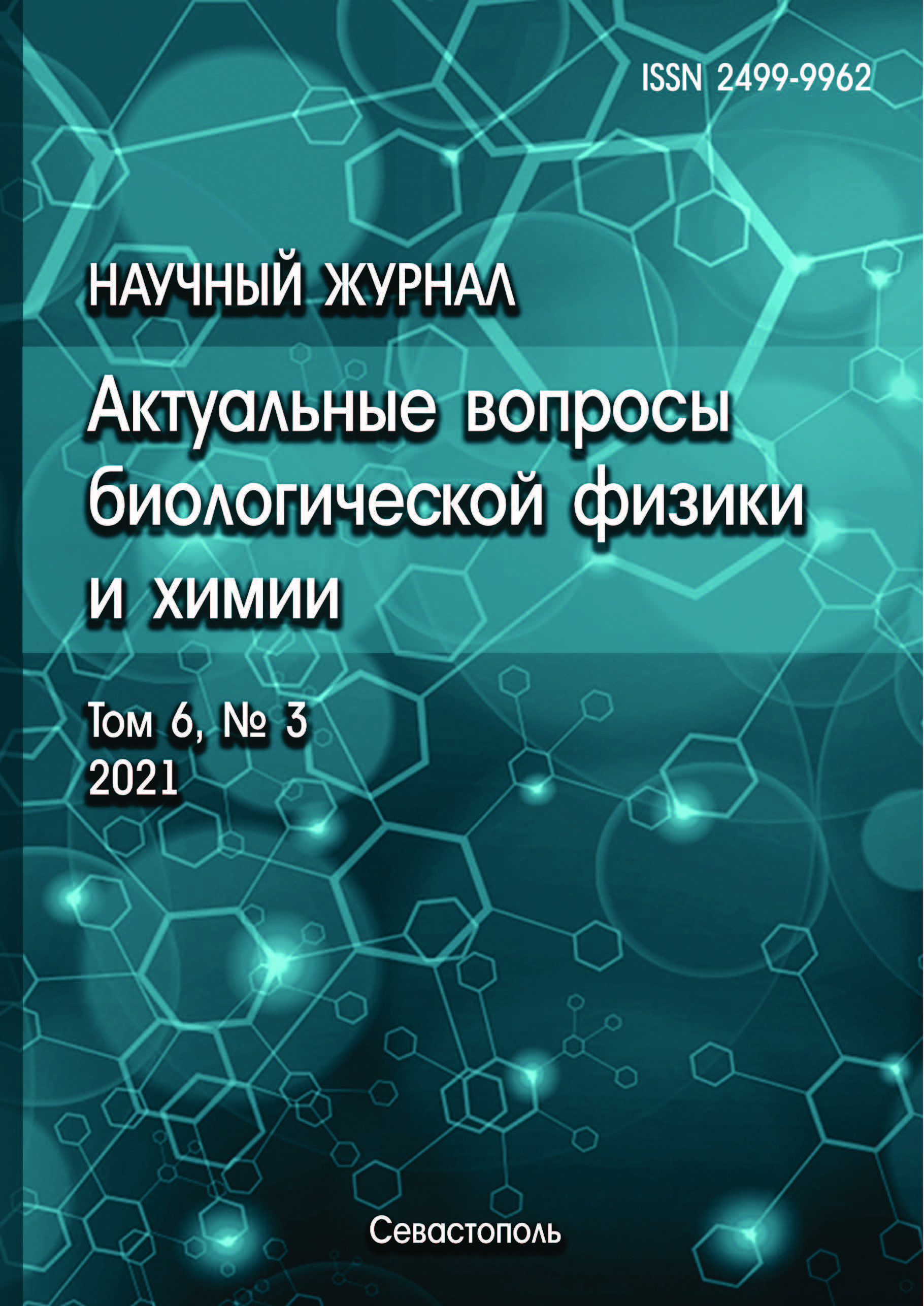Москва, г. Москва и Московская область, Россия
Впервые был применен комплексный подход к изучению взаимодействия монооксида азота и сероводорода-газотрансмиттеров, которые продуцируются бактериальными клетками в качестве сигнальных молекул. При исследовании кристаллических нитрозильных комплексов железа было установлено, что комбинированная обработка NO-донором и сероводородом, при условии 2.5-кратного избытка H2S на каждую NO-группу донора, стимулирует увеличение NO-сигнальной активности за счет образования более активных ДНКЖ с персульфидными лигандами в клетке, которые, в отличие от ДНКЖ с тиоловыми лигандами, дают характерный «узкий» ЭПР сигнал с gaver = 2,03 (g⊥ = 2.032, g|| = 2,02). Таким образом, H2S выступает медиатором NO-сигнальной активности, тем самым стимулируя значительное увеличение уровня экспрессии гена soxS. Влияние комбинированной обработки на уровень экспрессии гена sfiA обнаружено не было. Данное явление обуславливает снижение уровня окислительного стресса при совместной обработке NO-донором и H2S, что оказывает значительное влияние на снижение продуктивности формирования биопленок (в среднем на 30% относительно монообработки) и увеличение показателей дисперсии зрелых биопленок (в среднем на 25% относительно монообработки). Мы предполагаем, что применение комплексной обработки кристаллическими нитрозильными комплексами железа с сероводородом может быть востребовано для решения проблем борьбы с инфекциями, вызываемыми бактериальными биопленками.
монооксид азота, сероводород, биопленки, сигнальная активность
1. Davies D. Understanding biofilm resistance to antibacterial agents. Nat. Rev. Drug Discov, 2003, vol. 2, no. 2, pp. 114-122. doi:https://doi.org/10.1038/nrd1008
2. Macia M., Del Pozo J., Diez-Aguilar M., Guinea J. Microbiological diagnosis of biofilm-related infections. Diagnóstico microbiológico de las infecciones relacionadas con la formación de biopelículas. Enferm Infecc Microbiol Clin (Engl Ed), 2018, vol. 36, no. 6, pp. 375-381. doi:https://doi.org/10.1186/s12951-016-0246-1
3. Barraud N., Schleheck D., Klebensberger J., Webb J., Hassett D., Rice S., Kjelleberg S. Nitric oxide signaling in Pseudomonas aeruginosa biofilms mediates phosphodiesterase activity, decreased cyclic di-GMP levels, and enhanced dispersal. J Bacteriol, 2009, vol. 191, no. 23, pp. 7333-7342. doi:https://doi.org/10.1128/JB.00975-09 EDN: https://elibrary.ru/MZYEKT
4. Ding H., Demple B. Direct nitric oxide signal transduction via nitrosylation of iron-sulfur centers in the SoxR transcription activator. Proc. Natl. Acad. Sci, 2000, vol. 97, no. 10, pp. 5146-5150.
5. Lee S.J., Kim D.G., Lee K.Y., Koo J.S., Lee B.J. Regulatory mechanisms of thiol-based redox sensors: lessons learned from structural studies on prokaryotic redox sensors. Arch Pharm Res., 2018, vol. 41, no. 6, pp. 583-593. doihttps://doi.org/10.1007/s12272-018-1036-0 EDN: https://elibrary.ru/HMZSHX
6. Lobysheva I.I., Stupakova M.V., Mikoyan V.D., Vasilieva S.V., Vanin A.F. Induction of the SOS DNA repair response in Escherichia coli by nitric oxide donating agents: dinitrosyl iron complexes with thiol-containing ligands and S-nitrosothiols. FEBS Lett, 1999, vol. 454, no. 3, pp. 177-180. doihttps://doi.org/10.1016/s0014-5793(99)00777-2 EDN: https://elibrary.ru/LFNYMJ
7. Vasilieva S.V., Stupakova M.V., Lobysheva I.I., Mikoyan V.D., Vanin A.F. Activation of the Escherichia coli SoxRS-regulon by nitric oxide and its physiological donors. Biochemistry (Mosc), 2001, vol. 66, no. 9, pp. 984-988. doihttps://doi.org/10.1023/a:1012317508971 EDN: https://elibrary.ru/LGYICN
8. Kim S.K., Lee J.H. Biofilm dispersion in Pseudomonas aeruginosa. J Microbiol, 2016, vol. 54, no. 2, pp. 71-85. doihttps://doi.org/10.1007/s12275-016-5528-7 EDN: https://elibrary.ru/AHKJGS
9. Emeliyanova N.S., Shmatko N.Yu., Sanina N.A. Experimental and quantum-chemical simulation of pH-medium effects on the NO-donor activity of mononuclear nitrosyl iron complex [Fe(SC(NH2)2)2(NO)2]-l · H2O. Izv. Akad. Nauk. Ser. Khim., 2015, no. 10, pp. 2344-2350.
10. Aldoshin S.M., Sanina N.A., Davydov M.I. A new class of nitric oxide donors. Her.Russ. Acad. Sci., 2016, vol. 86, pp. 158-163. doi:https://doi.org/10.1134/S1019331616030096 EDN: https://elibrary.ru/WTGOIP
11. Tinajero-Trejo M., Jesse H., Poole R. Gasotransmitters, poisons, and antimicrobials: it's a gas, gas, gas! F1000Prime Rep., 2013, vol. 5, no. 28. doihttps://doi.org/10.12703/P5-28 EDN: https://elibrary.ru/RIXVMX
12. Scammahorn J.J., Nguyen I., Bos E.M., Van Goor H., Joles J.A. Fighting Oxidative Stress with Sulfur: Hydrogen Sulfide in the Renal and Cardiovascular Systems. Antioxidants (Basel), 2021, vol. 10, no. 3. doi:https://doi.org/10.3390/antiox10030373
13. Lloyd D. Hydrogen sulfide: clandestine microbial messenger? Trends Microbiol., 2006, vol. 14, no. 10, pp. 456-462.
14. Miller J. Experiments in Molecular Genetics. Cold Spring Harb. Lab. Press., 1972.
15. Васильева C.В., Стрельцова Д.А., Старостина И.А., Санина Н.А. Оксид азота участвует в регуляции сборки Fe-S-кластеров белков и формировании биопленок клетками Escherichia coli. Известия Российской академии наук. Серия биологическая. Академическая наука, 2013, № 4, с. 398-404. @@Vasilyeva S.V., Streltsova D.A., Starostina I.A., Sanina N.A. Nitric oxide participates in the regulation of the assembly of Fe-S-clusters of proteins and the formation of biofilms by Escherichia coli cells. Izvestiya Rossiiskoi Akademii Nauk. Seriya biologicheskaya, 2013, vol. 4, pp. 398-404. (In Russ.)
16. Vanin A.F. et al. EPR Characterization of mononuclear dinitrosyl iron complex with persulfide as a new representative of dinitrosyl iron complexes in biological systems: An Overview. Appl. Magn. Reson., 2014, vol. 45, no. 4, pp. 375-387. DOI: https://doi.org/10.1007/s00723-014-0523-9; EDN: https://elibrary.ru/QOTQVZ
17. Vanin A.F. Nitric Oxide Dinitrosyl iron complexes with thiol-containing ligands as a “working form” of endogenous nitric oxide. Nitric Oxide, 2016, vol. 54, pp. 15-29. doi:https://doi.org/10.1016/j.niox.2016.01.006 EDN: https://elibrary.ru/WWALVD
18. Whiteman M., Li L., Kostetski I., Chu S.H., Siau J.L., Bhatia M., Moore P.K. Evidence for the formation of a novel nitrosothiol from the gaseous mediators nitric oxide and hydrogen sulphide. Biochem. Biophys. Res.Commun., 2006, vol. 343, no. 1, pp. 303-310. doi:https://doi.org/10.1016/j.bbrc.2006.02.154
19. Dillon K.M., Carrazzone R.J., Matson J.B., Kashfi K. The evolving landscape for cellular nitric oxide and hydrogen sulfide delivery systems: A new era of customized medications. Biochem Pharmacol., 2020, vol. 176, 113931. doi:https://doi.org/10.1016/j.bcp.2020.113931 EDN: https://elibrary.ru/APOBSM
20. Ozfidan-Konakci C., Yildiztugay E., Elbasan F., Kucukoduk M., Turkan I. Hydrogen sulfide (H2S) and nitric oxide (NO) alleviate cobalt toxicity in wheat (Triticum aestivum L.) by modulating photosynthesis, chloroplastic redox and antioxidant capacity. J. Hazard Mater., 2020, vol. 388, 122061. doi:https://doi.org/10.1016/j.jhazmat.2020
21. Shatalin K., Shatalina E., Mironov A., Nudler E. H2S: a universal defense against antibiotics in bacteria. Science, 2011, vol. 334, no. 6058, pp. 986-990. doi:https://doi.org/10.1126/science.1209855 EDN: https://elibrary.ru/PEFRZX










